 Mobile Tutorial
Mobile Tutorial
 Mobile News
Mobile News
 How big is the 1-inch sensor of a mobile phone? It's actually bigger than the 1-inch sensor of a camera
How big is the 1-inch sensor of a mobile phone? It's actually bigger than the 1-inch sensor of a camera
How big is the 1-inch sensor of a mobile phone? It's actually bigger than the 1-inch sensor of a camera
Yesterday’s article didn’t mention “sensor size”. I didn’t expect people to have so many misunderstandings...
How much is 1 inch?
Due to some historical issues*, whether it is a camera or a mobile phone, the "1 inch" in the diagonal length of the sensor is not 25.4mm.
*Involving vacuum tubes, we do not expand them here. It is a bit like a horse’s butt deciding the width of a railroad track.
In order to avoid misunderstanding, the more rigorous writing is "Type 1.0" or "Type 1.0". Also, when the sensor size is less than 1/2 type, type 1 = 18mm; and when the sensor size is greater than or equal to 1/2 type, type 1 = 16mm.
So, the diagonal length of the 1/2 type sensor is 8mm, and the diagonal length of the 1/2.51 type sensor is 7.17mm. The latter is about 20% smaller than the former (not as it seems at first glance close to 40%).
*The actual length of the sensor diagonal has nothing to do with the "half circumference"! ! !
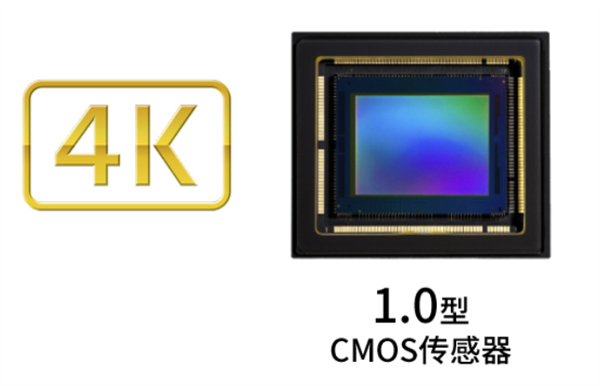
Medium format
Full frame is smaller than medium format, needless to say this. 44 x 33 medium format is about 68% better than 36×24 full frame.
How big is Super35?
Super35 covers a relatively large size range. For cameras, this size is basically equivalent to the 16:9 crop of the APS-C frame, which is smaller than the APS-C. For movie cameras, the width of many Super35 frames is much larger than the 23.5 of the APS-C. mm.
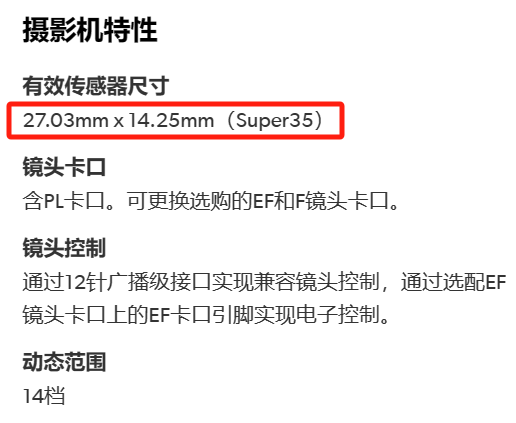
What exactly is M4/3?
M4/3 is neither the sensor size nor the sensor ratio. It is the earliest mirrorless system and a camera mount. Therefore, there is no such thing as "M4/3 format" - to describe the sensor size of most M4/3 cameras, it should be written as 4/3 type (inch) or 1.33 type (inch).
The most direct example: JVC GY-LS300 movie camera puts a 16:9 size Super35 frame sensor in the M4/3 mount. (The sensor size of Panasonic GH1/GH2/GH5S also exceeds 4/3 inches)
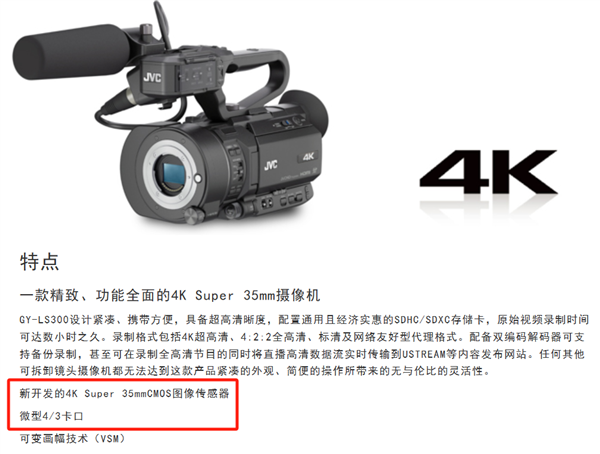
Is the "1 inch" on the phone the same as the camera?
I don't know why some people think that mobile phones are "opportunistic". In fact, the "1 inch" on Xiaomi, vivo, OPPO, and Huawei mobile phones is larger than the "1 inch" on Sony, Nikon, and Canon cameras. larger (about 10%).
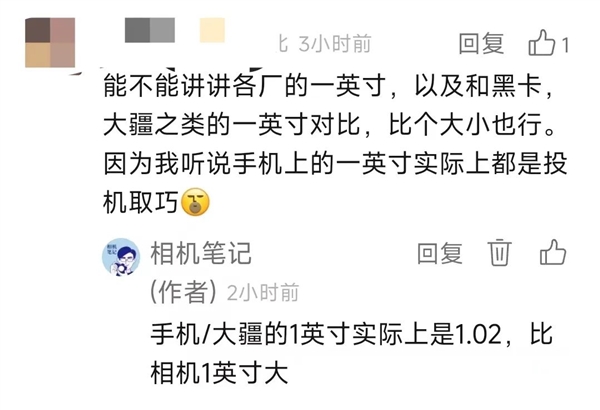
On the one hand, the actual size of the Sony IMX989 and LYT-900 sensors used in current mobile phones is type 1.02 (or type 1/0.98), with a diagonal length of 16.38mm ( The equivalent coefficient is about 2.64);
The sensor diagonal of the 1-inch camera is 15.86mm (the equivalent coefficient is about 2.73). On the other hand, mobile phones use a 4:3 ratio and cameras use a 3:2 ratio. Even if the diagonal lengths are the same, the phone sensor is larger than the camera.
* Regarding the ratio, it is generally believed that the 3:2 of full-frame and APS-C is inherited from the film ratio (44×33 medium format also corresponds to 645 film), while the 4:3 of mobile phones and compact cameras is inherited from Vacuum tube (predecessor of CCD/CMOS).
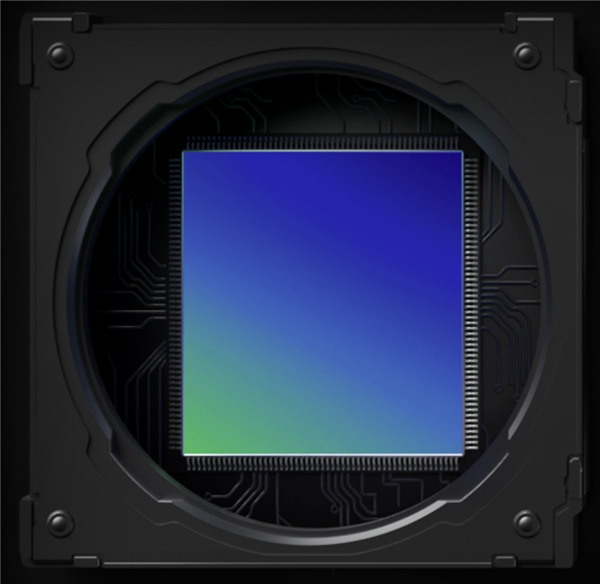
Attachment: Mobile devices using "1-inch" sensor
Type 1.02 4:3 approximately 50MP sensor (IMX989/LYT-900):
- Xiaomi 12S Ultra, 13Pro, 13Ultra, 14 Ultra
- vivo X90 Pro, X90 Pro, X100Pro (and the upcoming X100S Pro, X100 Ultra)
- OPPO Find X6 Pro, Find X7 Ultra
- Huawei Pura 70 Ultra
- Sharp AQUOS R7, R8 Pro, Leitz Phone 2 (using about 94% of the entire sensor)
- DJI Pocket 3 (uses approximately 94% of the entire sensor)
1.0 type 3:2 approximately 20MP sensor
- Panasonic CM1/CM10
- DJI Air 2S
-Sharp AQUOS R6, Leitz Phone 1
-Sony Xperia Pro-I (uses about 60% of the entire sensor)
-insta360 ONE R Leica version ( Approximately 94% of the entire sensor is used)
The above is the detailed content of How big is the 1-inch sensor of a mobile phone? It's actually bigger than the 1-inch sensor of a camera. For more information, please follow other related articles on the PHP Chinese website!

Hot AI Tools

Undresser.AI Undress
AI-powered app for creating realistic nude photos

AI Clothes Remover
Online AI tool for removing clothes from photos.

Undress AI Tool
Undress images for free

Clothoff.io
AI clothes remover

AI Hentai Generator
Generate AI Hentai for free.

Hot Article

Hot Tools

Notepad++7.3.1
Easy-to-use and free code editor

SublimeText3 Chinese version
Chinese version, very easy to use

Zend Studio 13.0.1
Powerful PHP integrated development environment

Dreamweaver CS6
Visual web development tools

SublimeText3 Mac version
God-level code editing software (SublimeText3)

Hot Topics
 1377
1377
 52
52
 Samsung's 10,000-yuan foldable phone W25 revealed: 5-megapixel under-screen front camera and thinner body
Aug 23, 2024 pm 12:43 PM
Samsung's 10,000-yuan foldable phone W25 revealed: 5-megapixel under-screen front camera and thinner body
Aug 23, 2024 pm 12:43 PM
According to news on August 23, Samsung is about to launch a new folding mobile phone W25, which is expected to be unveiled at the end of September. It will make corresponding improvements in the under-screen front camera and body thickness. According to reports, Samsung W25, codenamed Q6A, will be equipped with a 5-megapixel under-screen camera, which is an improvement over the 4-megapixel camera of the Galaxy Z Fold series. In addition, the W25’s external-screen front camera and ultra-wide-angle camera are expected to be 10 million and 12 million pixels respectively. In terms of design, the W25 is about 10 mm thick in the folded state, which is about 2 mm thinner than the standard Galaxy Z Fold 6. In terms of screen, the W25 has an external screen of 6.5 inches and an internal screen of 8 inches, while the Galaxy Z Fold6 has an external screen of 6.3 inches and an internal screen of 8 inches.
 Apple and Huawei both wanted to make a buttonless phone, but Xiaomi made it first?
Aug 29, 2024 pm 03:33 PM
Apple and Huawei both wanted to make a buttonless phone, but Xiaomi made it first?
Aug 29, 2024 pm 03:33 PM
According to a report from Smartprix, Xiaomi is developing a buttonless mobile phone codenamed "Suzaku". According to this news, this mobile phone codenamed Zhuque will be designed with an integrated concept, use an under-screen camera, and be equipped with Qualcomm Snapdragon 8gen4 processor. If the plan does not change, we are likely to see its arrival in 2025. When I saw this news, I thought I was back in 2019 - at that time, Xiaomi released the Mi MIX Alpha concept phone, and the surround-screen button-less design was quite amazing. This is the first time I have seen the charm of a buttonless mobile phone. If you want a piece of "magic glass", you must first kill the buttons. In "The Biography of Steve Jobs", Jobs once expressed that he hoped that the mobile phone could be like a piece of "magic glass".
 A new generation of thousand-yuan magic machine! Redmi Note 14 series joins the Internet: supports up to 90W fast charging
Sep 02, 2024 pm 12:44 PM
A new generation of thousand-yuan magic machine! Redmi Note 14 series joins the Internet: supports up to 90W fast charging
Sep 02, 2024 pm 12:44 PM
According to news on September 2, three new models of the Redmi Note14 series have been launched on the Internet, supporting up to 90W fast charging. According to various sources, this series will be released this month, focusing on the thousand-yuan market. 1. There are three models in the series, including RedmiNote14, RedmiNote14Pro and RedmiNote14Pro+. They are respectively equipped with Qualcomm Snapdragon 7sGen3, Dimensity 7350, and second-generation Snapdragon 7s. The Redmi Note14Pro series uses a 1.5K curved screen. This is Redmi’s first curved screen model this year and is consistent with the screen form of the previous generation Note13Pro+. RedmiNote14Pro series appearance: large-area centered three-camera solution camera Deco
 Honor Magic V3 big upgrade! Support Amap access to satellite communications
Sep 02, 2024 pm 01:54 PM
Honor Magic V3 big upgrade! Support Amap access to satellite communications
Sep 02, 2024 pm 01:54 PM
According to news on September 1, today, Honor MagicV3 received an important upgrade to MagicOS, which brought many new features and optimized experience. 1. In terms of satellite communications, Honor MagicV3 will support Amap’s access to satellite communications. Users can also initiate help through the “Satellite Help” function of Amap in a non-network environment. However, this function requires using a China Telecom card to activate the direct satellite connection service for mobile phones and upgrading the Amap App to version 15.0 or above. In terms of cameras, the imaging effects of the front camera, portrait and night scene modes in some scenes have been optimized to improve the photography experience. In terms of display, this upgrade improves the eye protection experience of the mobile phone screen and enhances the stability of the screen-off display scene. In addition, this update also improves the system
 Dimensity 9400 is the most powerful flagship! Vivo X200 Pro detailed parameters exposed
Sep 04, 2024 am 06:47 AM
Dimensity 9400 is the most powerful flagship! Vivo X200 Pro detailed parameters exposed
Sep 04, 2024 am 06:47 AM
According to news on September 4, today, blogger Digital Chat Station exposed the detailed configuration of vivoX200Pro. Vivo Dust-proof and waterproof, supports single-point ultrasonic fingerprint. Compared with the previous generation vivoX100Pro, the screen, performance, and images of the X200Pro have been significantly upgraded, especially in terms of imaging. This is the first time that vivo has equipped the Pro version with a 200-megapixel periscope telephoto lens. The X100Ultra ultra-large cup released by vivo previously used a 200-megapixel periscope telephoto lens.
 Xiaomi's 100-yuan phone Redmi 14C design specifications revealed, will be released on August 31
Aug 23, 2024 pm 09:31 PM
Xiaomi's 100-yuan phone Redmi 14C design specifications revealed, will be released on August 31
Aug 23, 2024 pm 09:31 PM
Xiaomi's Redmi brand is gearing up to add another budget phone to its portfolio - the Redmi 14C. The device is confirmed to be released in Vietnam on August 31st. However, ahead of the launch, the phone's specifications have been revealed via a Vietnamese retailer. Redmi14CR Redmi often brings new designs in new series, and Redmi14C is no exception. The phone has a large circular camera module on the back, which is completely different from the design of its predecessor. The blue color version even uses a gradient design to make it look more high-end. However, Redmi14C is actually an economical mobile phone. The camera module consists of four rings; one houses the main 50-megapixel sensor, and another may house the camera for depth information.
 Realme GT7 Pro is full of products: ultrasonic fingerprint, super large battery, and 100W fast charging are all listed
Aug 23, 2024 pm 03:31 PM
Realme GT7 Pro is full of products: ultrasonic fingerprint, super large battery, and 100W fast charging are all listed
Aug 23, 2024 pm 03:31 PM
According to news on August 23, according to digital bloggers Digital Chat Station, the product capabilities of the Realme GT7 Pro will be comprehensively strengthened, and its configuration will cover ultrasonic fingerprints, periscope telephoto, ultra-large batteries, and 100-watt fast charging. 1. Realme GT7Pro has a built-in large 6000mAh battery and supports 100W fast charging. The engineering machine does not support wireless charging, and the mass production model is unknown. Equipped with single-point ultrasonic fingerprint recognition and supports IP68/69 dustproof and waterproof. Equipped with LYT6003X periscope, it does not support telephoto macro. Equipped with a 1.5K resolution equal depth four-curved screen, using BOE X2 substrate. It uses the Snapdragon 8Gen4 processor and supports up to 16GB of memory and 1TB of storage. The Realme GT7Pro is expected to be launched as soon as Q4 this year.
 Xiaomi Redmi Note 14 mobile phone passed FCC certification: pre-installed with Thermal HyperOS and equipped with 33W charger
Sep 02, 2024 pm 02:52 PM
Xiaomi Redmi Note 14 mobile phone passed FCC certification: pre-installed with Thermal HyperOS and equipped with 33W charger
Sep 02, 2024 pm 02:52 PM
Thanks to netizen Wu Yanzu from South China for submitting the clue! According to news on September 2, the international version of Xiaomi Redmi Note 14 with model number "24094RAD4G" has now passed FCC certification, revealing some configuration information of the machine. FCC certification information shows that Xiaomi Redmi Note14 mobile phone is pre-installed with ThePaper HyperOS1.0 system, supports Wi-Fi, Bluetooth, LTE and 5GNR frequency bands, and is equipped with a 33W charger. Xiaomi RedmiNote14 series mobile phone information update Xiaomi RedmiNote14 has passed IMEI certification and supports 45W fast charging (the actual charging rate is unknown). It is equipped with MediaTek Dimensity 6100+ processor. Xiaomi RedmiNote14Pro internal code name: "Ame



